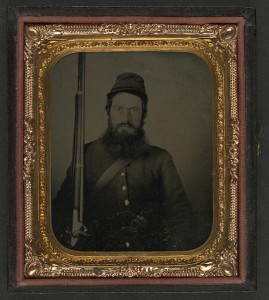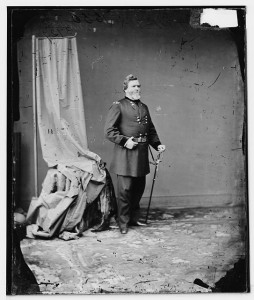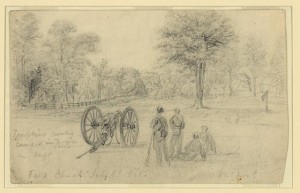We found out a couple days ago that the 19th NY Volunteer Infantry had arrived in Pleasant Valley, Maryland. General Nathaniel P. Banks, having taken command of Robert Patterson’s Union army, decided to move it north of the Potomac River. The 19th was organized at the end of April, but it has seen no real battle. Probably the most notable feature of the 19th is its shabby gray uniforms. Thankfully, 150 years ago today the 19th got proper blue uniforms. From Cayuga in the Field by Henry Hall and James Hall:
[At Pleasant Valley] the Cayuga regiment was encamped for three weeks. Here also, it was rejoined by a detachment of sick and nurses, which had been left at Kalorama. The regiment was held under rigid discipline, and improved rapidly in steadiness and soldierly bearing. Guard duty along the Potomac, and the canal and railroad on its bank, from Sandy Hook to Berlin, required daily detachments from the companies. The upper Potomac at this time formed the frontier of war in this quarter. The Union forces, under Banks, held and acted on the north bank, from Williamsport, twenty miles above Pleasant Valley, to the Monocacy, twenty miles below. The rebels watched the fords and scouted along the river on the Virginia side. Our pickets often talked with the rebel pickets, and met them half way in the stream and exchanged papers.
During July, twenty-one men were discharged from the 19th for disability, used up by hard service.
July 29th, Gen. Banks issued orders for the reorganization of his army. So many militia regiments had gone home, that the old brigades were all cut up, and now the new three years’ regiments, raised under the President’s second call, were arriving, sometimes five or six in a day. As the old 8th Brigade was, in a day or two, to lose the 5th and 12th Militia, a consolidation with other regiments of the army was effected, and a new brigade was temporarily formed, designated as the 1st of the army. It embraced the 2d United States Cavalry, Col. George H. Thomas; 2d New York and 9th Rhode Island battery; 19th New York Volunteers, Col. Clark; 28th New York Volunteers, Col. Donnelly; 28th Pennsylvania Volunteers, Lt. Col. Geary; and the 2d Pennsylvania Reserves, Col. Mann. It was placed under the command of Col. George H. Thomas, afterwards one of the most renowned Generals of the army. Col. Thomas was a specimen of the perfect soldier. Of a fine personal presence, he was gentlemanly, considerate of the kind of forces he had to command, without a single bad habit, and a brave and daring officer. He was loved and respected by every soldier in his command. Green as the troops were, he could have led them anywhere, and they would have done their duty under him to the last man.

Nice uniform - not sure about the shoes (Unidentified soldier in Union uniform LOC - LC-DIG-ppmsca-36915)
July 30th, excitement and joy agitated Camp Cayuga. Regulation uniforms came. They had been following the regiment for a month. That night, on dress parade, the Cayugas wore for the first time the long sighed for, comfortable army blue. The shoddy, worn and torn to rags, was cast off with a parting shudder. Gov. Morgan’s shoddy shoes having worn out, leaving half the men barefoot, foot gear was next supplied by borrowing five hundred pairs of new shoes from Connecticut and Massachusetts regiments encamped in the Valley. New life for a while thrilled the whole command.
The regiment again pined for active service. Opportunities for a fight with the rebels were eagerly watched for. …
Everything is going great as long as the 19th can borrow some shoes.
The enemies meeting half way in the Potomac to exchange newspapers until they can fight again another day
George Henry Thomas was serving in the 2nd U.S. Cavalry when the war broke out. He soon would move to the Western Theater.




Pingback: “crying for water” | Blue Gray Review